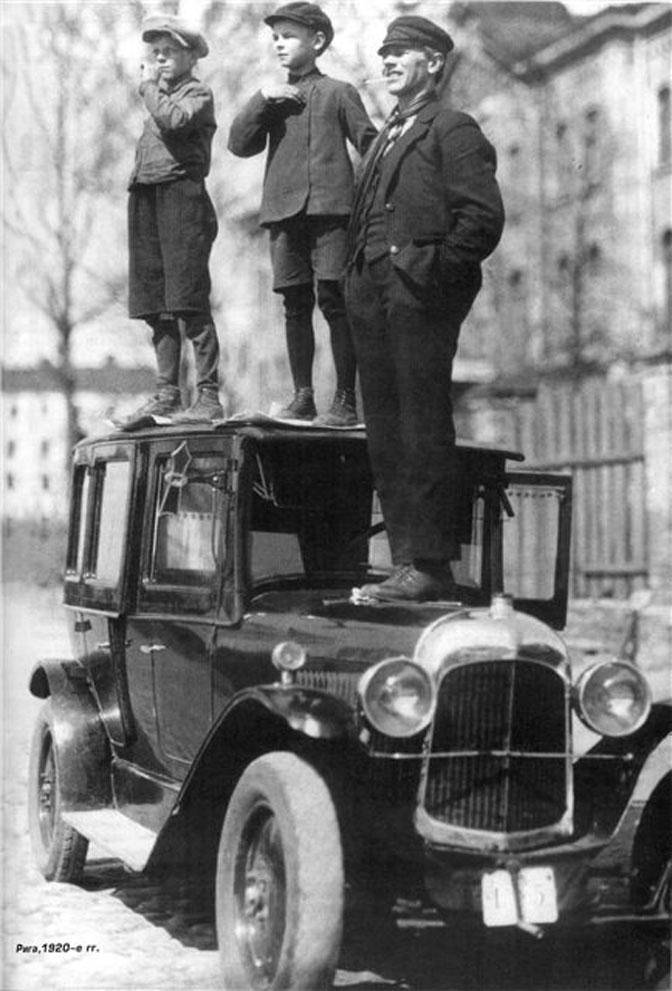
Latvian Boys' Garments: Hosiery

Figure 1.--This photograph was taken in Riga, Latvia, during the 1920s. Notice the style of the automobile and cthe cturn signal. Two small boys and a man are standing on top of a car, obviously to watch a parade of some sort. I wonder how the owner of the car felt about its being used as a public perch for parade watchers. We would guess that the man was the owner. It does look as though the boys have laid down some sheets of a newspaper to protect the paint on the roof of the car. The boys look rather disheveled, especially the boy whose long stockings are so wrinkled. The second boy has much neater long stockings. The boys are clearly wearing supporters but their garters seem to have lost all or most of their elasticity and produce a very ugly appearance in one case. Mother would not have been pleased. Of course we have no idea of what sort of parade was being watched.
|
|
Latvian children wore the same variety of hosiery we see in other countries European countries, especially the northern countries like Germany and Russia. As far as we call tell, trends in Latvia were the same as the other Baltic republics. This was because the climate was the same and the the geopgraphic position was similar and politica;/economic tremds were similar. We have little information on the 19th century during which Latvia was controlled by Russia. We notice Latvian children wearing both knee socks and long stockings during the early-20th century. Long stockings were especially common during the cold weather. Latvia on the Baltic has cold winters. And as many boys wore knee pants/short pants, the long stockings helped keep them warm. A good example is an unidentified Latvian boy in the 1930s. The country was briefly independent during the inter-War era. German fashions were influential even while Lstvia was part of Tsarist Russ\ia. The German influence was even more importanbt during the intert-War era. Latvian hosiery seems very similar to German styles until World War II when the country was invaded and annexed by the Soviet Union. Long stockings continued to be widely worn in Latvia during the Winter into the 1960s. This was common throughout the Soviet Union. Knee socks were also widely worn. We see more children wearing ankle socks after World War II. We are not sure at this time if Latvian hosiert trends varied in any meaningful way from the rest of the Siviet Union.
Trends
Latvian children wore the same variety of hosiery we see in other countries European countries, especially the northern countries like Germany and Russia. As far as we call tell, trends in Latvia were the same as the other Baltic republics. This was because the climate was the same and the the geopgraphic position was similar and politica;/economic tremds were similar. The fashion industry in neigbiring Germany was also very important.
Chronology
We have little information on the 19th century during which Latvia was controlled by Russia. We know much more about the 20th century. The country was briefly independent during the inter-War era. German fashions were influential even while Latvia was part of Tsarist Russ\ia. The German influence was even more importanbt during the intert-War era. Latvian hosiery seems very similar to German styles until World War II when the country was invaded and annexed by the Soviet Union. Long stockings continued to be widely worn in Latvia during the Winter into the 1960s.
Latvian children wore a variety of hosiery. We notice Latvian children wearing both knee socks and long stockings during the early-20th century. Long stockings were especially common and almost universal during the cold weather. Latvia on the Baltic has cold winters. And as many boys wore knee pants/short pants, the long stockings helped keep them warm. A good example is an unidentified Latvian boy in the 1930s. This was also common in Germany and throughout the Soviet Union. Knee socks were also widely worn. We see more children wearing ankle socks after World War II. We are not sure at this time if Latvian hosiery trends varied in any meaningful way from the rest of the Soviet Union. Presumably climate was a factor. We see Latvian children wearing tights in the 1970s when throughout the Siviet Union, tights replaced long stockings. During the warmer weather ankle socks became ibncreasingly common. Here as more boys wore long pants. long stockings were no longer neded. Younger boys still often wore tights.
HBC

Related Baltic Pages in the Boys' Historical Web Site
[Estonia]
[Latvia]
[Lithuania]
[Prussia]
Related Chronolgy Pages in the Boys' Historical Web Site
[The 1880s]
[The 1890s]
[The 1900s]
[The 1910s]
[The 1920s]
[The 1930s]
[The 1940s]
[The 1930s]
[The 1940s]
[The 1950s]
[The 1960s]
[The 1970s]
[The 1980s]
Related Style Pages in the Boys' Historical Web Site
[Long pants suits]
[Knicker suits]
[Short pants suits]
[Socks]
[Eton suits]
[Jacket and trousers]
[Blazer]
[School sandals]
[School smocks]
[Sailor suits]
[Pinafores]
[Long stockings]
Navigate the Boys' Historical Clothing Web Page
[Return to the Main Latvian garments page]
[Return to the Main Latvian page]
[Return to the Main country sailor suit page]
[Introduction]
[Activities]
[Bibliographies]
[Biographies]
[Chronology]
[Clothing styles]
[Countries]
[Girls]
[Bibliographies]
[Contributions]
[FAQs]
[Glossaries]
[Images]
[Links]
[Registration]
[Tools]
[Boys' Clothing Home]
Created: 9:01 PM 12/15/2011
Last updated: 2:44 AM 4/26/2012



